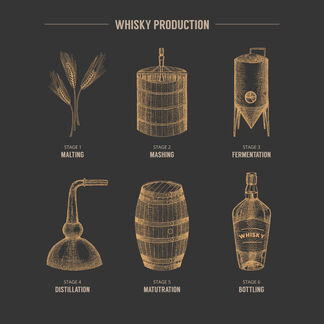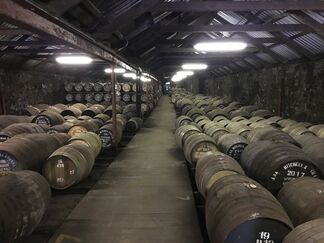How is whisky made?
The six steps in whisky production
June 2022: Often wondered how whisky is made? Why are whiskies different colours? Why are some smooth and some taste like an old ashtray? Well read on and find out! There are six main stages in making whisky. The process I am describing here all apply to Scotch single malt whisky and there are some differences in the process for other origins.
The six stages are called: Malting, Mashing, Fermentation, Distillation, Maturation and finally Bottling.
This Blog entry will walk you through each stage and assess what influence each has on the final product.
Malting
An essential ingredient of Scotch single-malt whisky is barley. Malted barley is the source of sugar used to make alcohol. Barley is malted by dampening the barley grain with water and allowing it to germinate. In this process, starch is converted to sugar. To stop the process, and to prevent the barley from growing, the germinating grain needs to be dried. The method of drying will set one of the first influences of taste in the final whisky. Some of the malted barley is dried with burning peat - which will result in a peaty influence in the taste. Another method is by using heated air which will have very little influence on the final taste.
Malting is quite an expensive part of the process and many distilleries do not malt their own barley but source it from "malt houses". There are only a handful of distilleries that do malt barley themselves - the most important of which are Balvenie, Bowmore, Highland Park, Laphroaig and Springbank.
Mashing
Once the barley has been malted, it is ground (milled) to a rough powder (called grist) and mixed with warm water in a "mash tun". The mash tun is a huge vat often made of oak. The mashing process extracts the sugar from the grist and results in a very sweet liquid. Mashing is a 3-stage process to ensure the maximum amount of sugar is released. The first is done at 65 degrees centigrade. The second is at 80 degrees centigrade and the third is at 95 degrees. Although each distillery will adjust this to their own processes and taste goals. Once the sugar water has been drained off, the remaining mash is dried in specialised plants used as animal feed.
Fermentation
After the sugar solution has cooled to below 20 degrees centigrade, fermentation is started by adding yeast. Around 50kg of yeast are added to 15,000 litres of sugar solution and the yeast would bot survive if the sloution would be warmer than 20 degrees. Fermentation takes place in a vat called a "wash back". During fermentation, the yeast works to convert the sugars into alcohol and after between 2 and 4 days (depending on the distillery process) the liquid (now called wort - or sometimes beer) has between 8% and 9% alcohol content.
During fermentation, mechanical blades are used to stir the fermenting liquid to break up the foam and reduce the risk of bacteria forming in the wort. The wash backs are often made of cypress wood which further limits the risk of infection. Some distilleries now use steel wash backs. Wash backs are cleaned very regularly to ensure they are completely clean before re-use.
Distillation
So far, the process is very similar to the production of beer. Albeit without any hops. But the next stage in whisky production is where the alcohol level is increased dramatically.
Distillation takes place in copper "stills" which are often the most recognised equipment of a distillery.
The wort, or beer, is filled into the first copper pot still, called a wash still, and is heated. Today mainly hot steam is used for heating. Hot steam is lead through specially shaped heating tubes inside the pot still. At 78° C, the alcohol starts to evaporate before the water does. The alcohol steam rises in the tapered tube.
Over the neck and the lyne arm the steam is led into a condenser where the alcohol steam is liquefied again. The water mostly remains in the pot still. All Single Malt Whisky distilleries work with at least two series-connected pot stills. The first one, the wash still, distils the wash to 20% to 25% of alcohol. The resulting liquid is called “low wines”. The low wines are then transferred into the second pot still, called a "spirit still", where they are distilled to an alcohol content of 65% to 70%. Some distilleries use a third still. This third pot still produces even purer alcohol at more than 75%.
The alcoholic spirit produced at this stage is crystal clear - looking just like water - but is incredibly strong in alcohol and quite un-drinkable!
During distillation, the unique shape of the pot stills is another contributing factor to the taste of a Whisky. A long and slim shape produces soft, pure alcohol, while a short, squat shape produces strong, intense flavours. The intensity of the heating is also important for the taste. If you heat too strongly, many accompanying substances and fusel oils will get into the Whisky, which will surely not be as smooth as if it had been distilled slowly. Typically the distillation process in the spirit still takes up between 4 and 8 hours.
Bottling
More decisions face the distillery at the time of bottling. A cask may simply be bottles as a "single cask" or "single barrel" whisky. This limits the number of available bottles and also makes ut quite unique. Another bottling decision comes from cask combinations. These could be many casks of a similar cask type, and from a single whisky production run. Or combinations of cask types which are decided on by the distillery. As long as the casks contain whisky of the same age and production batch, it remains a single malt whisky and can carry the age in years. Where single malt whiskies of different ages are mixed, the whisky is a blended single malt but without an age statement (often referred to as NAS, or No Age Statement).
Whisky when bottled can be at an alcoholic strength - known as cask strength - or can be diluted with water. If diluted, the distiller must remember that anything less than 40% alcohol by volume (ABV) cannot be called scotch whisky.
Maturation
Whisky is not whisky until it has been matured for at least 3 years and 1 day in an oak cask. It is the time spent in the cask, and the type of cask used, that gives single malt whisky its colour and contributes to its flavour. For single malt scotch whisky, the cask must be made of oak, but may (or may not) have been used before to store other alcoholic drinks. Common casks are new oak, re-used bourbon casks, port or sherry casks and more recently casks that have previously contained wines or rum.
The variety of casks used have an extremely large influence over both the colour and the taste of the whisky. A new oak cask will provide a whisky which is golden brown with a taste (and aroma) of vanilla. A re-used sherry or port cask will provide a much darker whisky with added sweetness. The best way to learn about this, though, is through personal experience at a tasting!
Casks are stored in a warehouse and kept humid and cool. The reason comes from the angels who insist on taking their share! The Angels Share is the alcohol that escapes into the atmosphere from the casks during storeage. This means that younger whiskies are often stronger in alcohol content than older ones. The location of the warehouse has a further influence over the taste of a whisky. As the angels take their share, the level of the spirit in the cask drops and air from the local atmosphere comes in to the cask. If whisky is warehoused close to the sea, for example, then there may be a saltiness in the whisky taste.
After 3 years in a cask, the spirit becomes whisky. It can be kept in the cask longer than that of course! Most whiskies will stay in the cask until they are bottled, but some whiskies are transferred to another cask for their last few months of maturation to "finish" the whisky. This will further develop the flavour and colour depending on the type of cask used for the finish.


